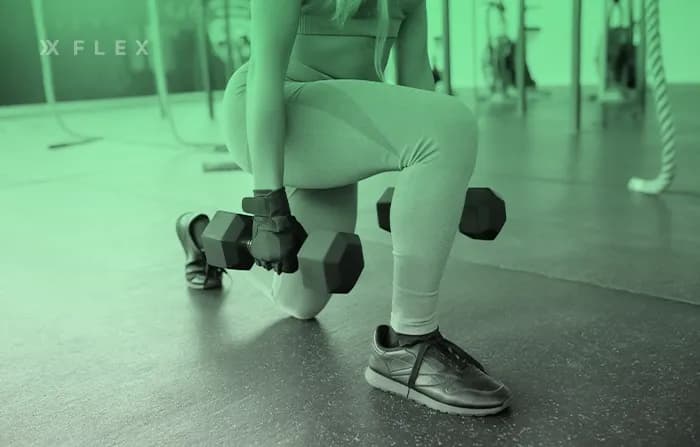Shape Your Glutes With These Glute Dumbbell Exercises
This is a quick guide to glute dumbbell exercises. Learn the top 5 glute dumbbell exercises to build a sculpted lower half.
Let’s face it: A sculpted butt looks great! Many people hit the gym with dreams of scoring a bigger, perkier butt. But here's the real deal: beyond the aesthetics, the glutes are MVPs for our overall health.
Now, what if you want to grow your glutes but have nothing but a pair of dumbbells? Do you need machines and a barbell for that? Not necessarily! If you work out at home or go to the gym after 6 PM (we all know how busy the gym is after 6 PM), you can still have a killer workout with your dumbbells.
After reading this article, you’ll know about the structure of the glutes and what they do for our bodies. Plus, you’ll learn some awesome glute dumbbell exercises you can do to build your glutes. If you're looking for how to get a round butt, keep reading.
The Structure of the Gluteal Muscles
The gluteal muscles, or the glutes, are actually composed of three muscles: gluteus maximus, gluteus medius, and gluteus minimus. To understand the structure of the glutes, you should first understand some other body parts:
- Ilium: the upper portion of the hip bone
- Sacrum: a bone located at the lower part of the spine
- Coccyx: a technical name for the tailbone
- Femur: the long bone inside our thighs
- Iliotibial tract: a band of tissue along the side of the thigh
- Greater trochanter of the femur: a bony structure at the top of the femur
Now, let’s break down the structure of these three muscles:
Gluteus maximus:
- The largest one
- Origin: ilium, sacrum, and coccyx
- Extension: femur and iliotibial tract
- Location: highest and most superficial compared to the other two
The gluteus maximus is the one who decides how our buttocks look. Question: “So, should I train only my glute max?” No. Keep reading to find out why other muscles are also important.
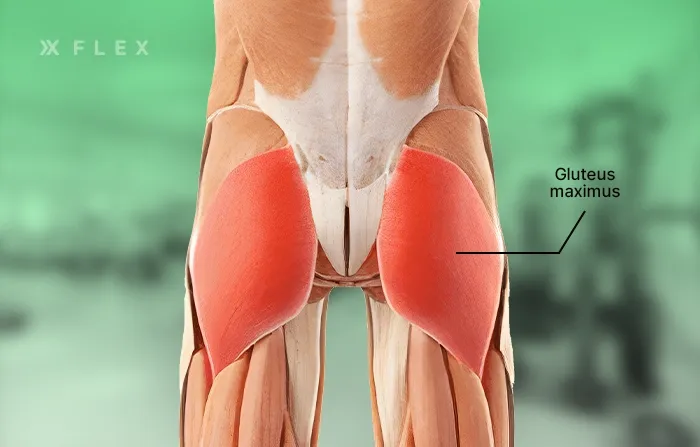
Gluteus medius:
- The second-largest of the gluteal muscles
- Origin: the surface of the ilium
- Extension: greater trochanter of the femur
- Location: below gluteus maximus
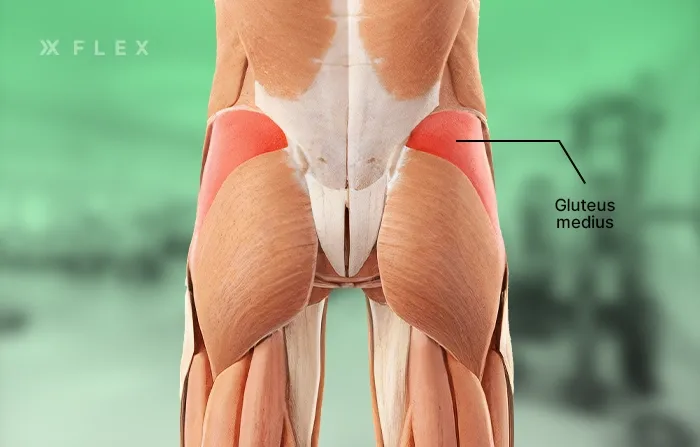
Gluteus minimus:
- The smallest gluteal muscle
- Origin: ilium
- Extension: greater trochanter of the femur
- Location: deep-seated within the hip area
To strengthen this muscle, you can try gluteus minimus exercises like hip abductions or clamshells.
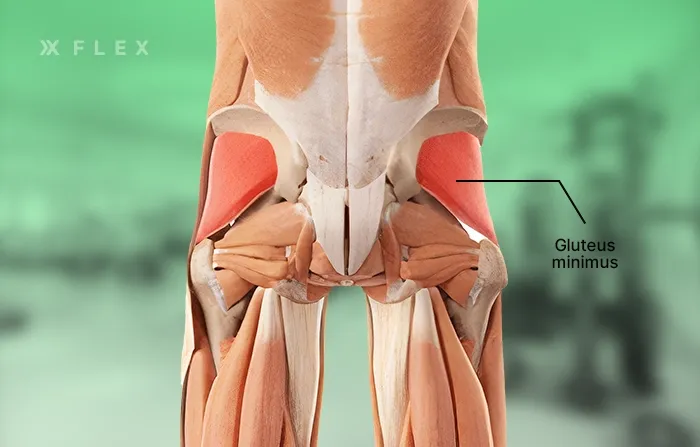
Now, let’s see them together:
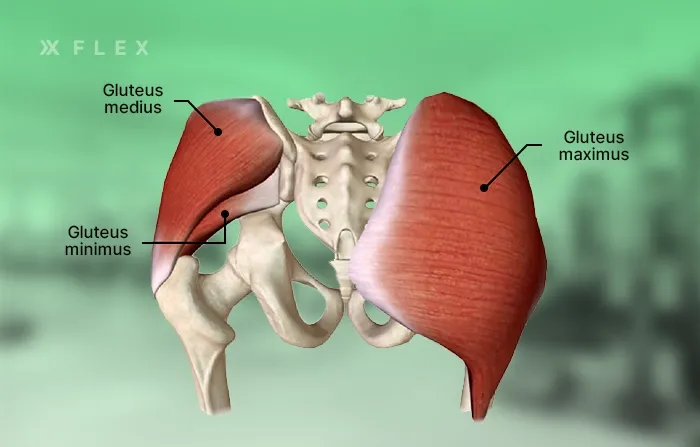
The Functions of the Glutes
The glutes have an important role in the way our body looks. However, there’s so much more to the glutes than simply being nice to look at. The gluteal muscles are important for our movement and functional well-being.
The most important thing that the glute max does for us is hip extension. Hip extension is the opposite of hip flexion, which is when you bring your thighs to your stomach. This means that hip extension happens when you put your legs straight on the ground or when you move them backward, thus extending the hips. Hip extension is important in walking or running. Another function of the glute max is the external rotation of the thigh. This is when you turn your knee and thigh outwards, like when you want to slide in a car.
The gluteus medius and minimus also get in on the action. They help us perform hip rotation. As its name suggests, hip rotation refers to when you rotate your hips internally or externally. You might think that you don’t have control over your hips’ movement and that it’s impossible to rotate them. However, this can be done when you’re turning your thighs and knees outwards or inwards. Think about sitting cross-legged. This movement involves hip rotation.
Abduction is another favor that the glute medius and minimus do for us. Abduction means moving your leg to the side while your knees point forward. Ever been in the way of someone? You need abduction to be able to let them pass.
In general, the gluteal muscles are one of the most important factors in body stabilization. If you have strong glutes, your other body parts will have a stable base to lean on. This means that you will also have good posture, which will protect you from future problems, such as lower back pain.
One research paper says that strong glutes help us have proper knee position, thus preventing knee valgus. This is a condition that makes our knees become crooked and leaning inward. Having knee valgus can eventually cause osteoarthritis.
Glute Dumbbell Exercises
People used to be more active in the old days. Life wasn’t limited to sitting at a desk, and most jobs required some degree of physical activity. Nowadays, almost everything is automated. Therefore, we don’t need to get up and get moving like before. Plus, most people have to work with a computer for long hours. This means a sedentary lifestyle for many.
Sitting down a lot has consequences, one of which is a condition called sleepy glutes. When our movement is limited, our gluteal muscles experience atrophy and gradually weaken. Basically, they’ll forget how to perform properly. This disrupts our body’s natural condition and will result in low back and knee pain. It can also give you the appearance of an inverted butt, a pancake butt or even a square butt. Not so hot.
In the following, we’ll introduce some of the best dumbbell glute exercises that will help you strengthen your gluteal muscles.
Glute-Biased Dumbbell Squat
Squats are compound exercises that target almost all lower-body muscles to some degree. However, when performed in a traditional way, the focus of a squat is mainly on the quadriceps. There are some adjustments you can make to make a squat more glute-biased. To perform a glute-biased dumbbell squat:
- Stand with your legs shoulder-width apart, your torso straight, and toes pointed slightly outwards.
- Hold two dumbbells by your sides.
- Keep looking forward throughout the whole movement without bending or rotating your neck.
- Take a deep breath and engage your core.
- Slowly start sitting down by pushing your hips backward and knees outwards. Your knees should never rotate towards each other.
- Make sure the weight is distributed evenly and not heavy on your toes.
- While you’re coming down, slightly lean your torso forward. This increases hip flexion, activating glutes to a higher degree. Make sure you’re not rounding your back.
- Try to go below parallel or parallel to complete the range of motion.
- Come back up by pushing your heels to the ground.
There is no inherently correct or incorrect way to hold a dumbbell. Some individuals may find discomfort in holding the dumbbells by their sides, as it may interfere with the movement.
If this is the case for you, consider using a single, heavier dumbbell and holding it against your chest while performing squats. This variation is called a goblet squat.
Another option is holding one dumbbell with hands extended between your legs. This can be a good choice as it encourages leaning forward.
Hip Thrust
For most people, hip thrust is the go-to move for working those glutes. Sure, it gets the quads, hamstrings, and adductors in on the action, but the star of the show? That's definitely the gluteus maximus!
Professional lifters usually perform hip thrusts with a barbell. This allows them to lift really heavy weights. However, if you’re a beginner who’s not there yet and doesn’t have any equipment but a dumbbell, the hip thrust can also count as a good glute dumbbell exercise. Here’s how:
- Sit on the ground and put your shoulder blades against a bench.
- Pick up a dumbbell and put it over your hips. Hold the dumbbell with your hands.
- Open your feet hip-width apart and bend your knees.
- Your feet shouldn’t be too close or too far away from your hips. When you lift your hips, your shins should make a vertical line with your thighs.
- Keep your chin tucked to avoid neck pain.
- Engage your core and lift your hips until they make a straight line with your shoulders.
- At the top, push your hips forward and squeeze your glutes. Keep your pelvis tucked during the movement, and don’t arch your back.
- Hold for a few seconds and slowly come down until your glutes are a few inches above the ground.
Reverse Lunge
Let’s talk lunges! Lunges are one of the best compound exercises for the lower body. They have three variations: forward lunge, reverse lunge, and walking lunge. They all target the most important lower-body muscles such as the glutes, hamstrings, and quads—but they’re slightly different.
Studies show that while forward lunges are more quad-dominant, reverse lunges put the gluteus maximus under more tension. They still target all gluteal muscles to some degree. This makes them one of the best dumbbell glute exercises. Here’s how to do it:
- Stand straight with your feet together and your toes pointing forward.
- Hold two dumbbells by your side with a neutral grip, your palms facing your body.
- Brace your core and put one leg backward as far as you are comfortable. Keep your front heel deeply rooted in the ground.
- Your back foot shouldn’t be placed directly behind your front foot. Make sure there’s a lateral distance between your two legs.
- Bend your knees and start going down.
- Go down as far as you can until your front thigh makes a 90° angle with the floor.
- You can keep your torso straight or slightly lean forward to activate more glutes.
- Come back up and put your back leg in the starting position.
- You can alternate between legs or do them separately.
Curtsy Lunge
If you want an elevated butt, you gotta work those booty shelves, aka the gluteus medius. Just like all lunges, a curtsy lunge works all leg muscles, but it has an extra focus on the glute medius and the hip adductors. To perform this glute dumbbell exercise:
- Your starting position is the same as a reverse lunge.
- Take a big step back with one of your legs and cross it behind your front leg. Ideally, your back knee should slightly pass your front foot.
- Go down until your front thigh makes a vertical line with the ground. Try to keep the weights near your knee.
- Come back up and return to the starting position.
Step-Up
Step-ups are another compound exercise that zero in on multiple lower-body muscles. However, by adjusting a few things, you can turn it into a good dumbbell exercise for the glutes. Performing step-ups is quite easy. Here’s how to do a glute-biased step-up:
- Stand in front of a step or a plyo box. The higher the step, the more your glutes will be activated.
- Hold two dumbbells with your hands. If you have trouble keeping your balance, use a heavier weight on the same side as your raised leg and hold onto something with your other hand for support.
- Step on the box with one leg and come up while leaning slightly forward without rounding your back.
- Try to keep the weights close to your knees. This helps with the leaning forward.
- When you’re up on the box, bring your hanging foot’s toes to the edge of the box. You don’t need to stand on both legs fully.
- Slowly come back down by taking a wide step backward. The further back you go, the more it will work your glutes.
- Don’t drop yourself down. Keep the movement under control.
- When your toes touch the ground, repeat the movement by coming back up.
Keep It Simple
You’re looking for a way to grow your glutes and want to focus on nothing but glute exercises—we get it. Still, you should know that growing your glutes will take years of patience and effort and that there is no quick fix. On top of that, it can get pretty boring!
There are countless new exercise variations that are claimed to be “the best glute dumbbell exercise.” But as wise people, we shouldn’t take random advice from strangers on the internet. When it comes to the glutes, Bret Contreras, a doctor who has spent years studying how the glutes grow and who is also known as the 'The Glute Guy,' is one of the best ones to seek advice from.
He claims that we don’t yet know the best exercise that’s definitely going to grow the glutes. But he knows one thing for sure: consistent practice of basic compound exercises and gradually increasing their intensity will give you better results than jumping from one fad workout to another.
If you want to have workouts that will give you results, you should try Flex A.I. All you need to do is download the app for free and get personalized workout plans, track your progress, and learn how to do exercises.
Related articles


Get fit with Flex
Build muscle & lose weight fast for free.
Available on iPhone + Apple Watch
